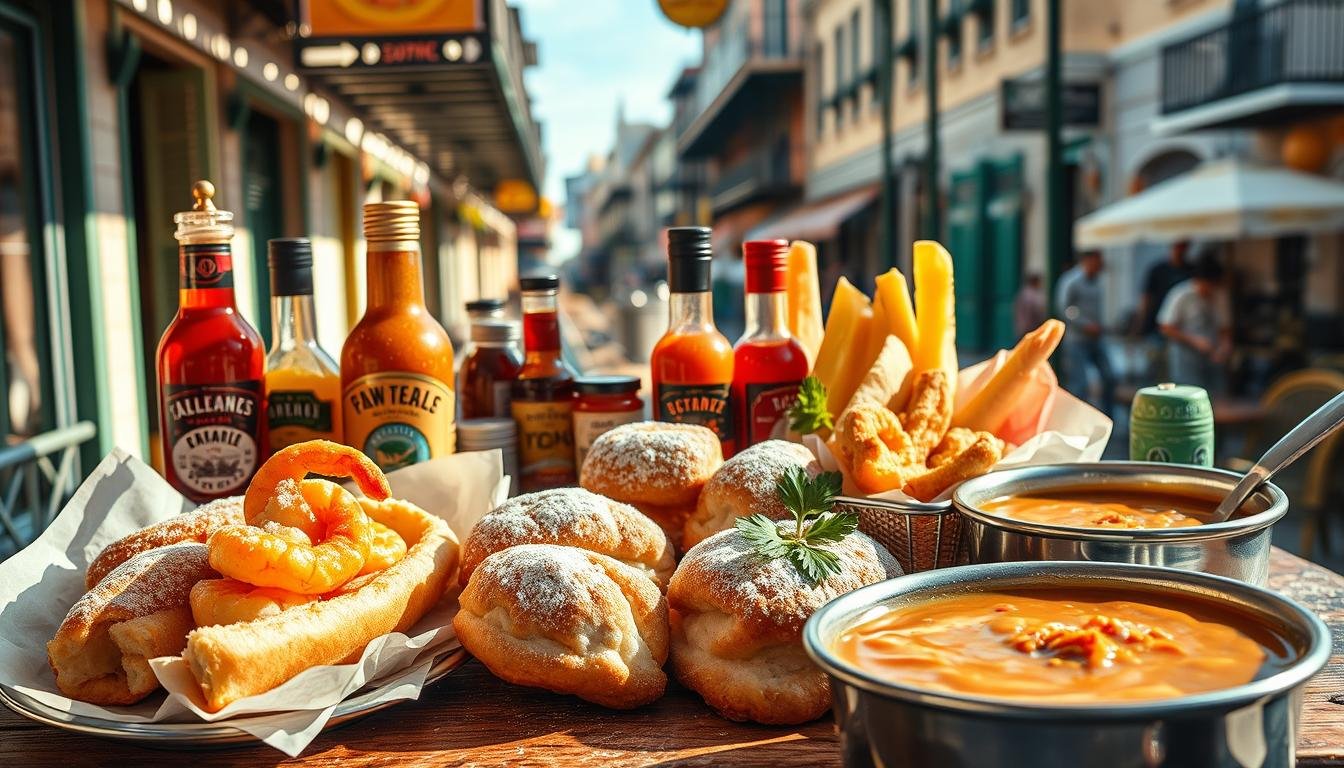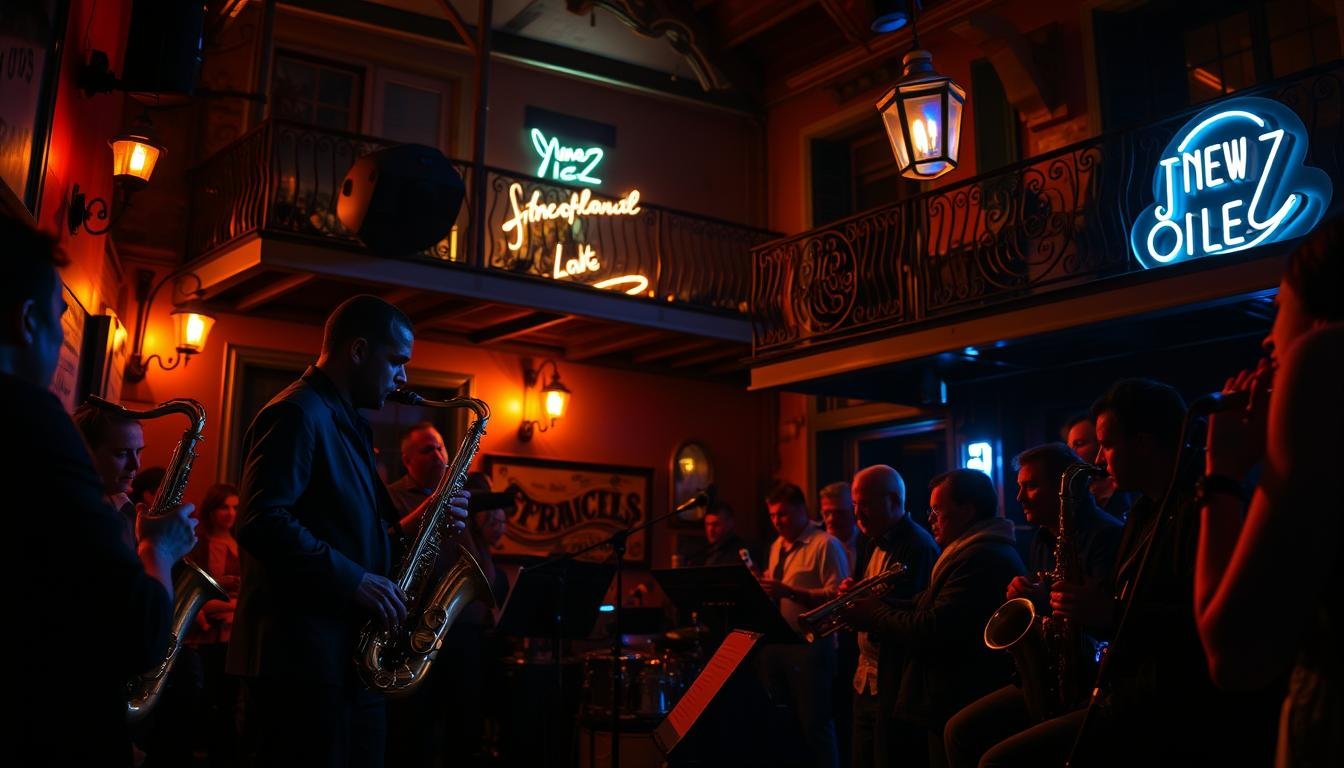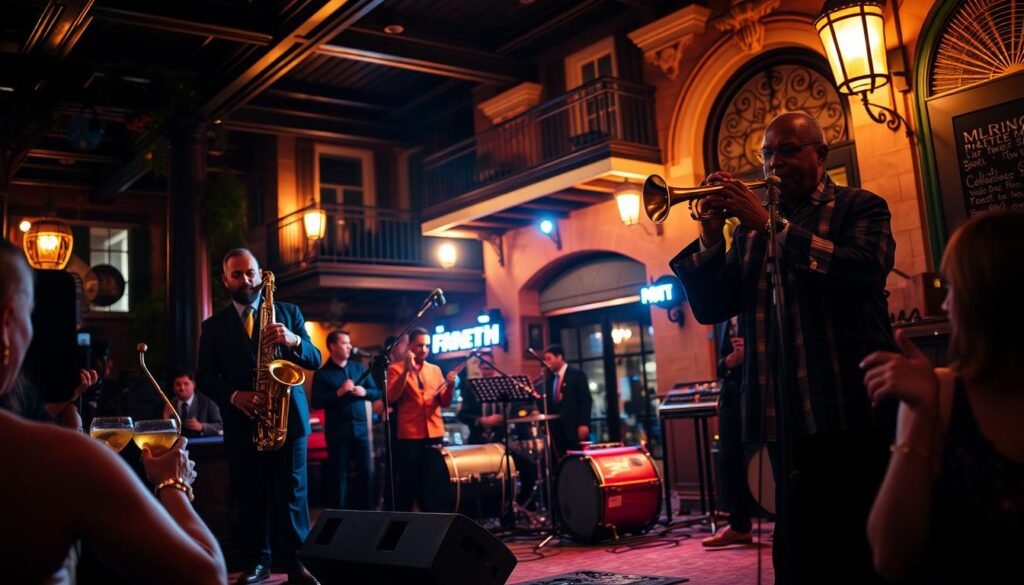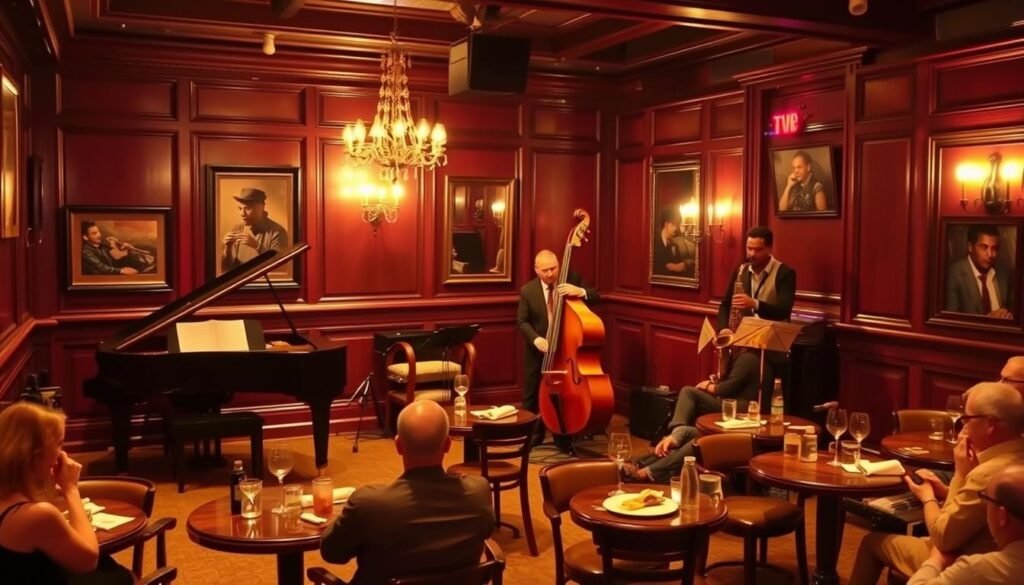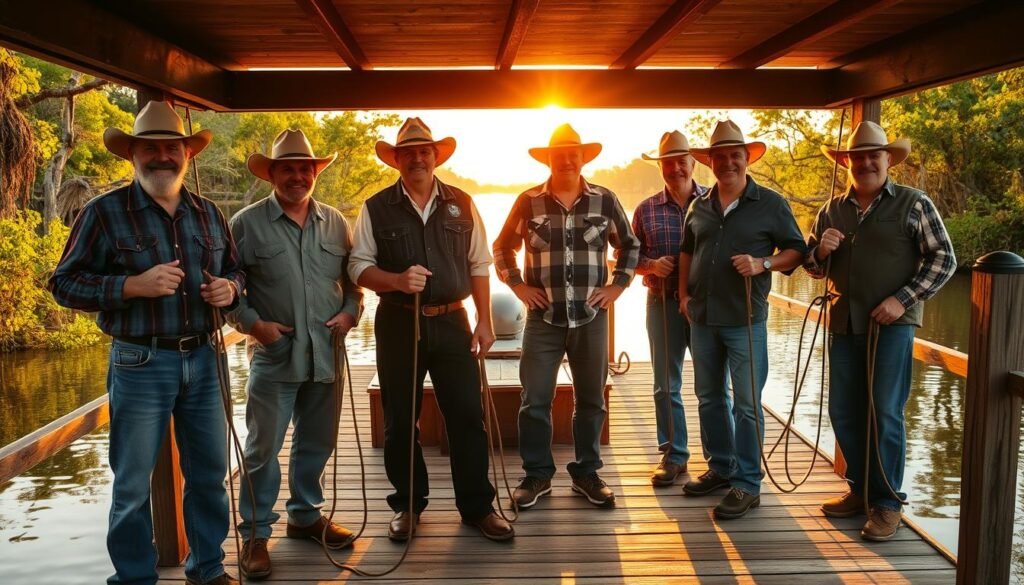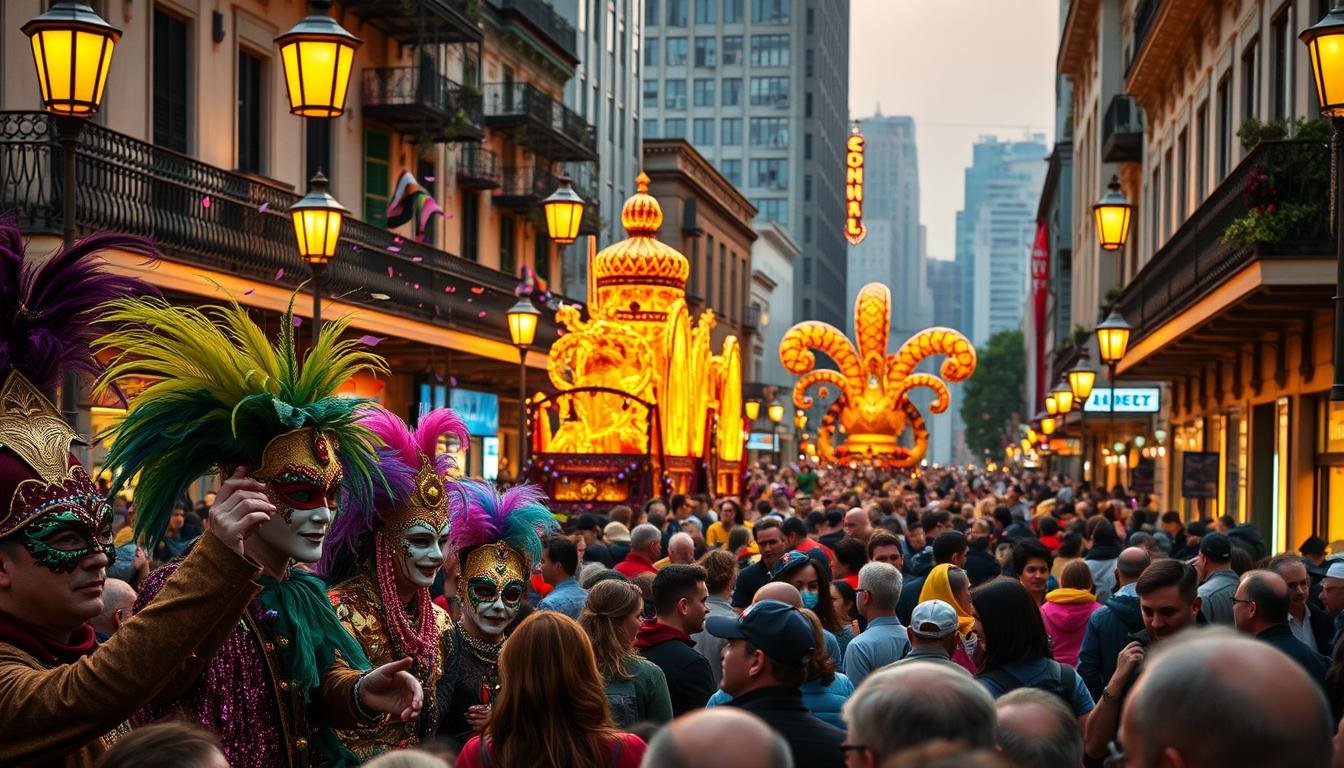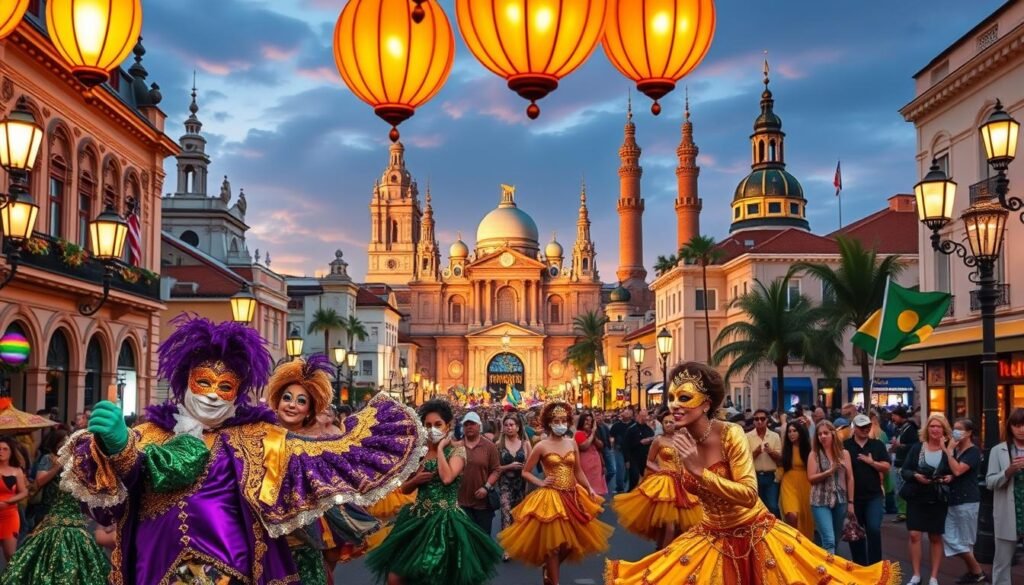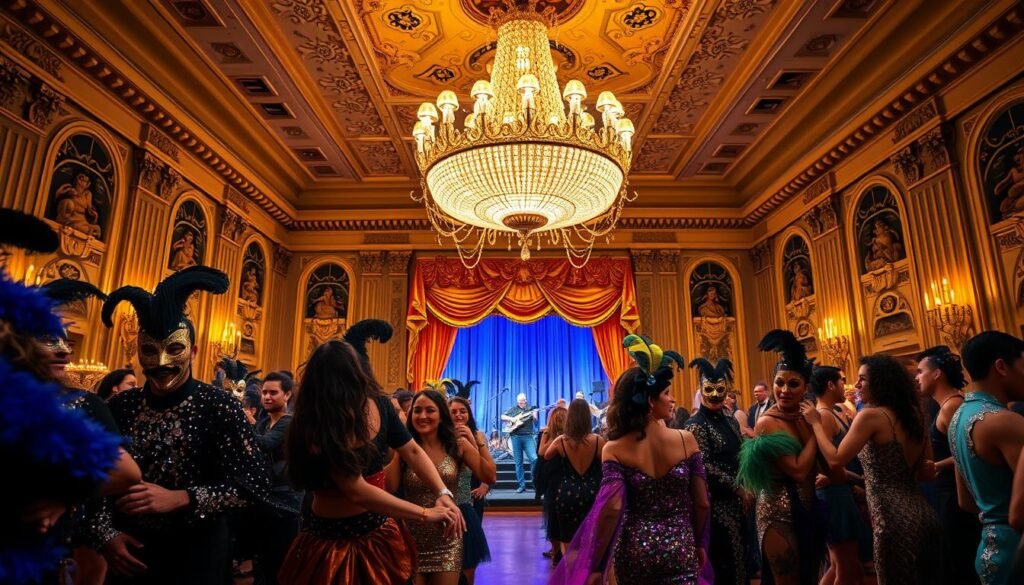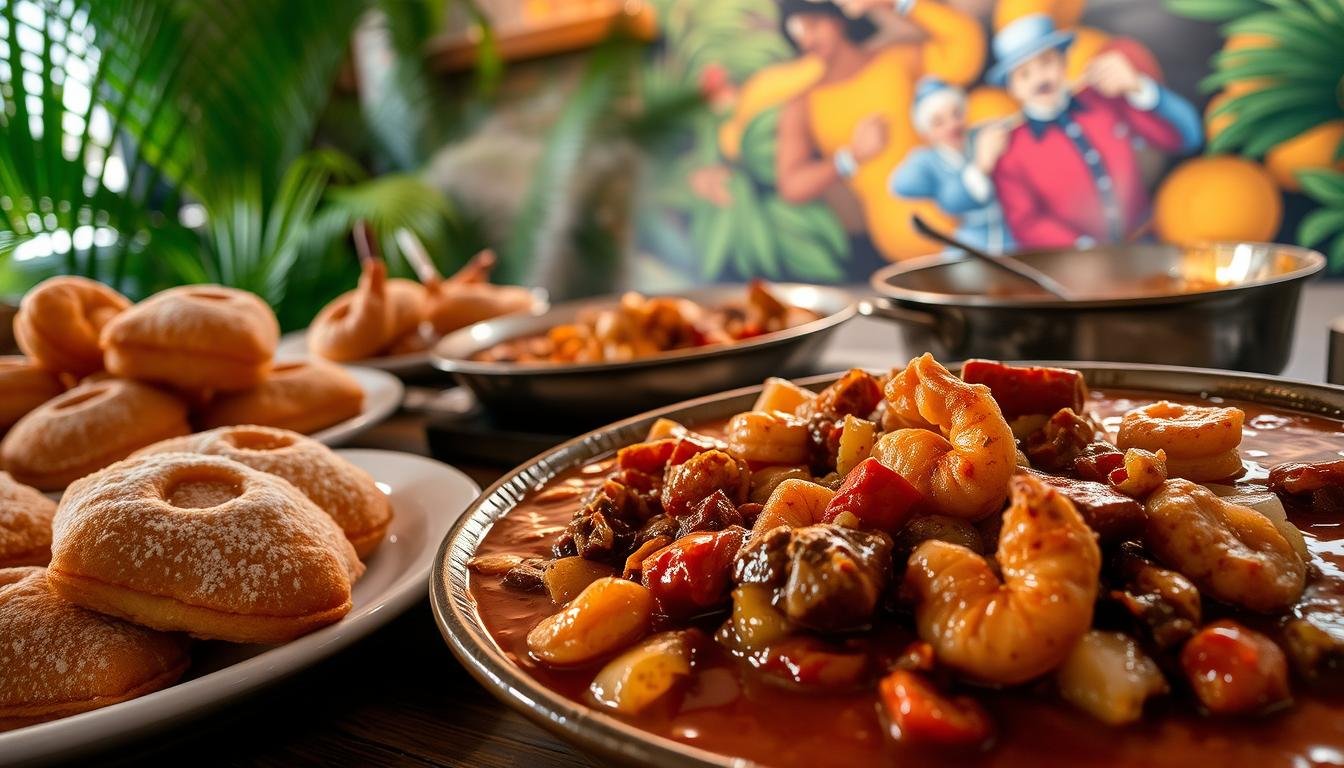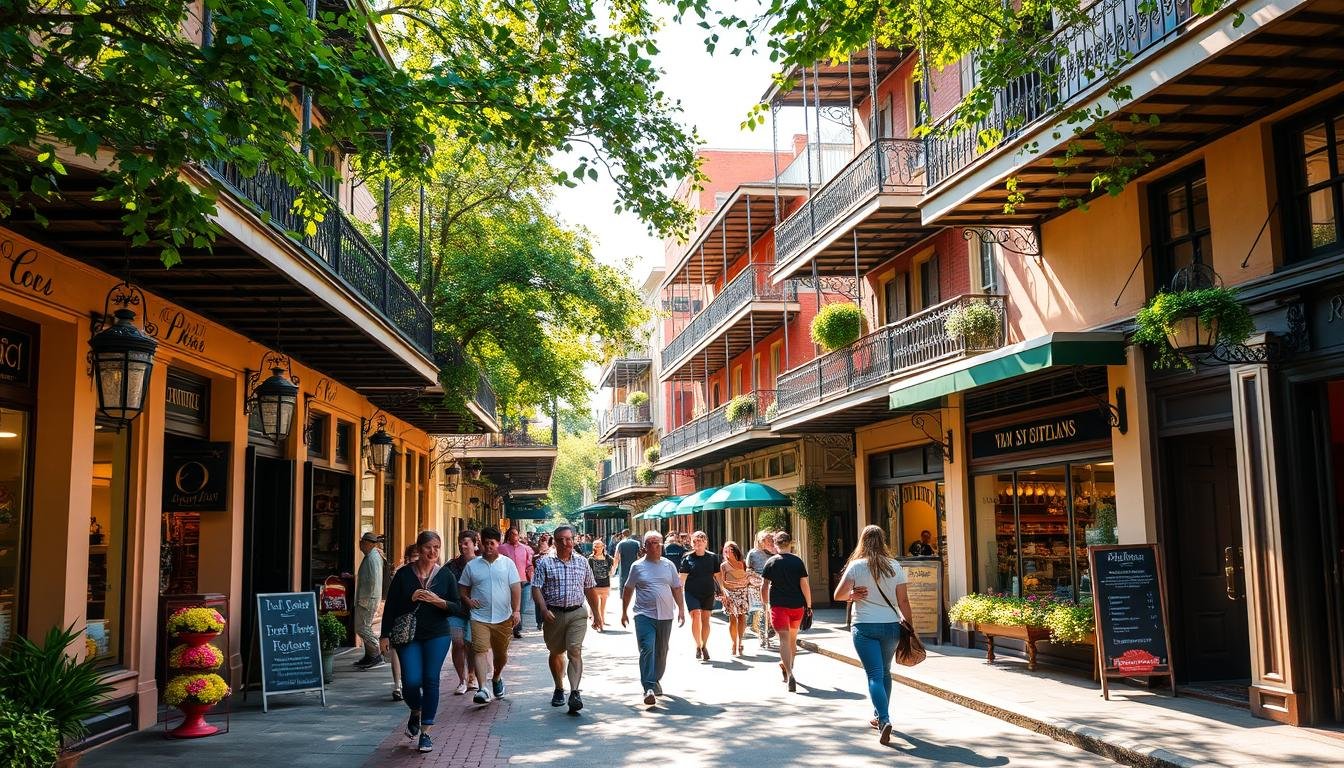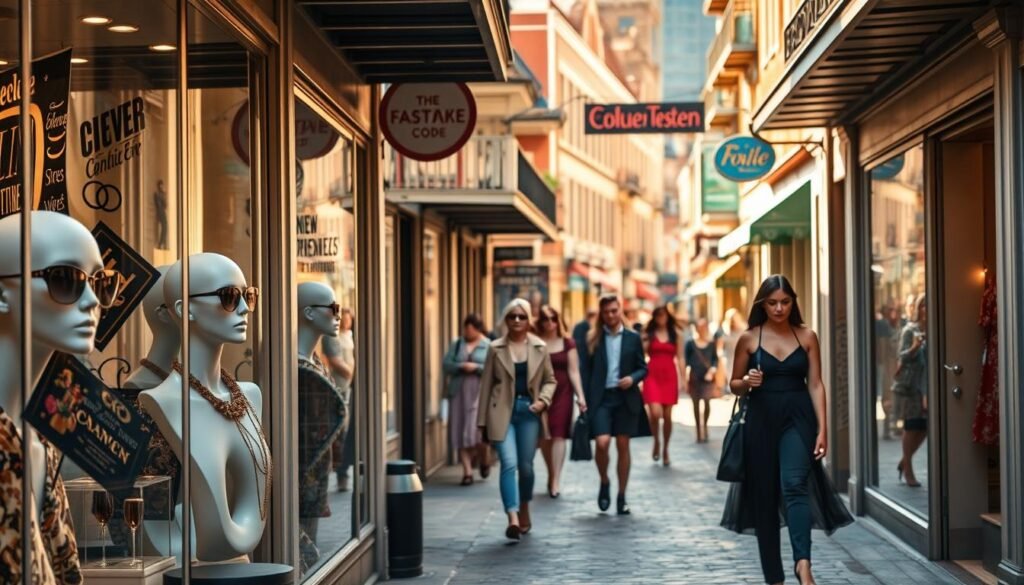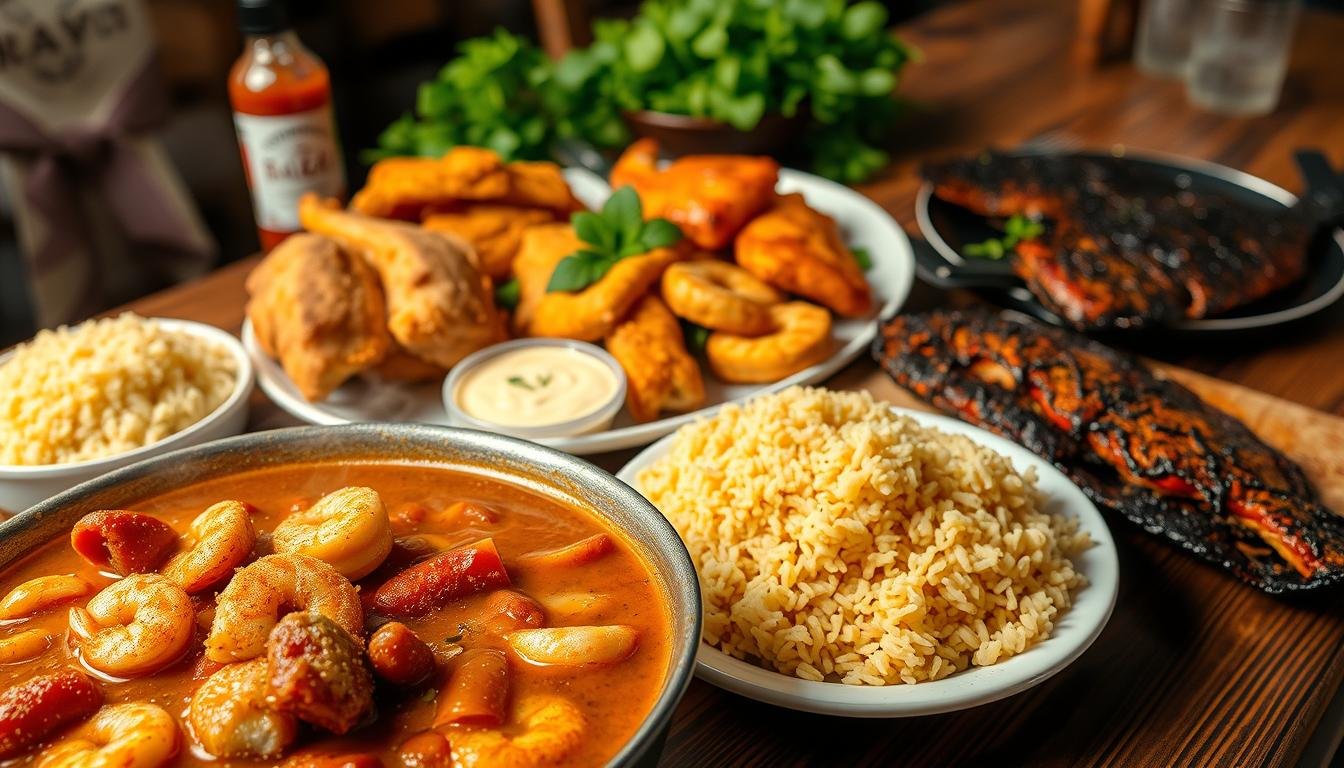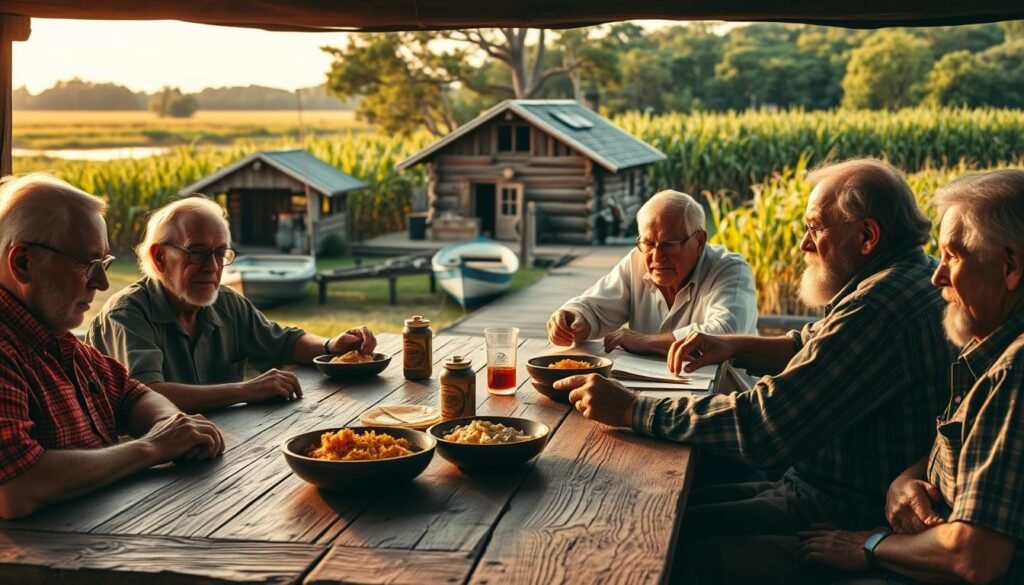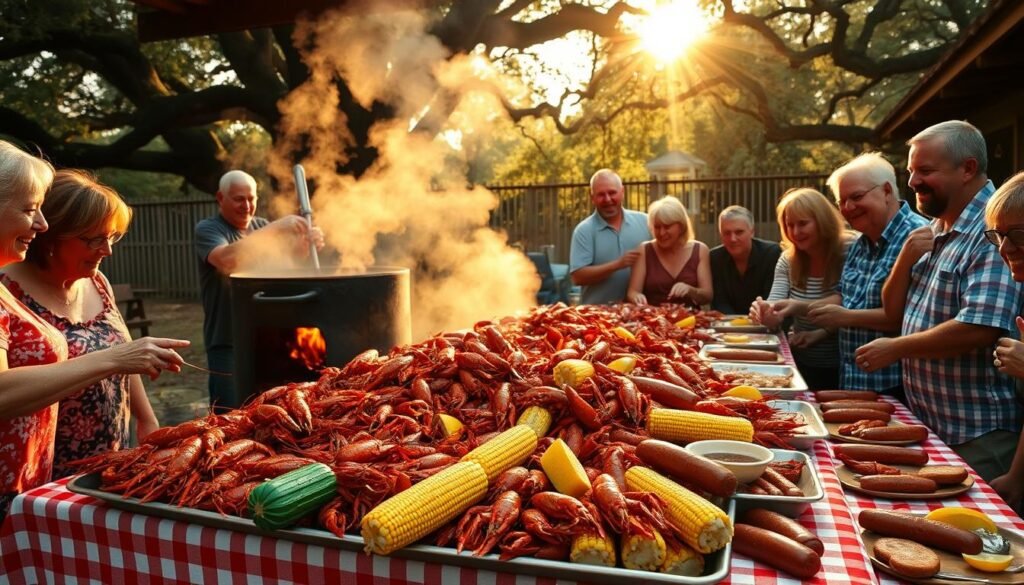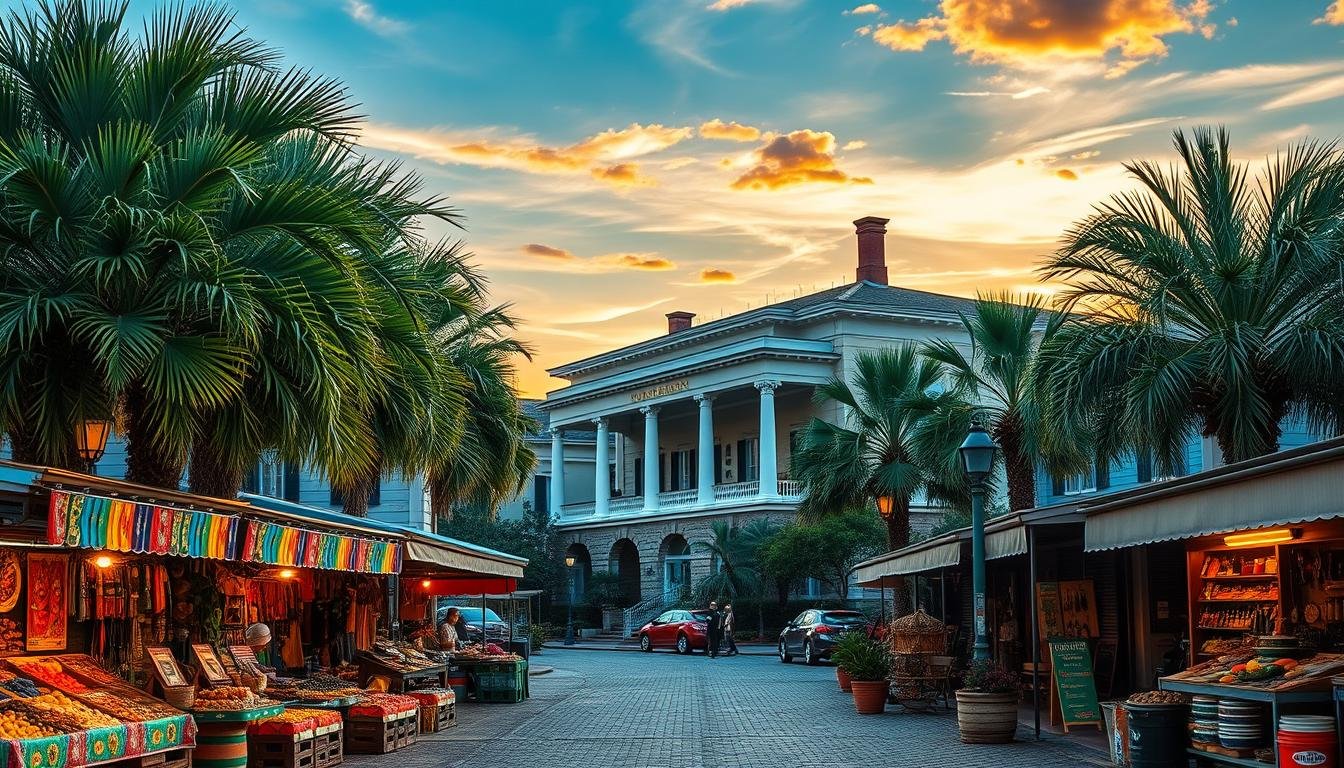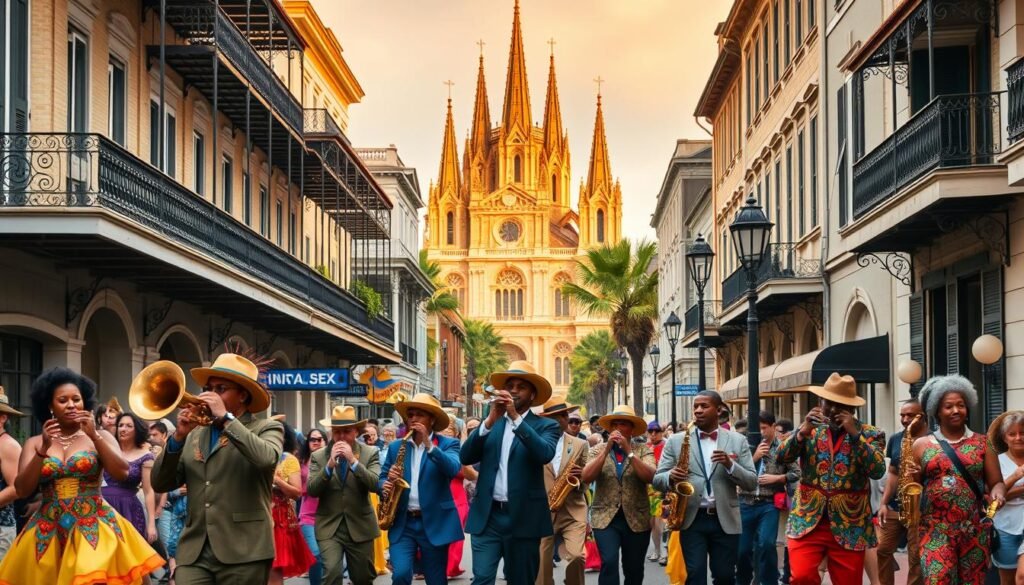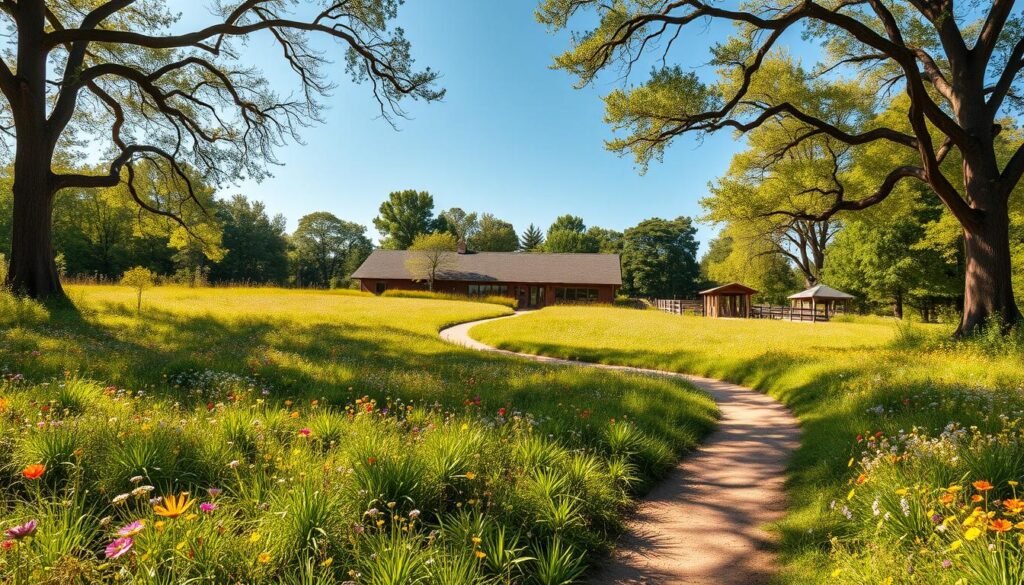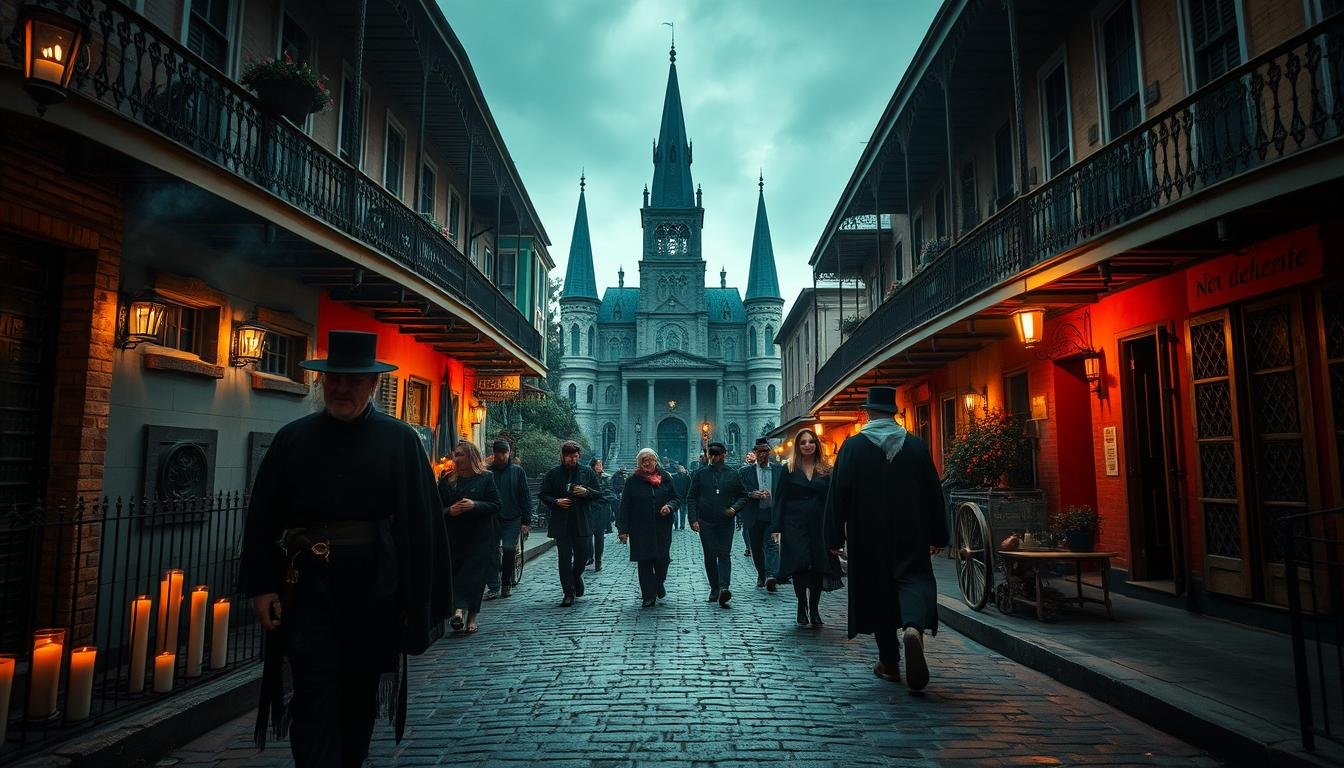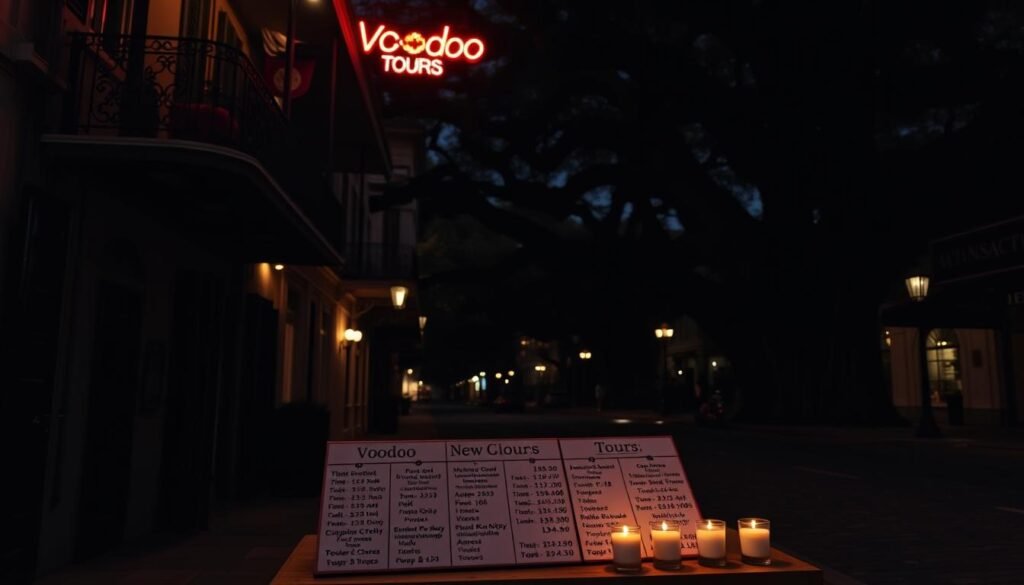As a local, I’m excited to take you on a culinary journey through the vibrant streets of New Orleans. The city’s cuisine is a melting pot of flavors, influenced by its rich history and cultural heritage.
From spicy Cajun and Creole dishes to sweet beignets and jazz-age cocktails, the city’s culinary delights will tantalize your taste buds and leave you wanting more. I’ll share my insider knowledge on the best eats, from iconic restaurants to street food and food trucks.
Key Takeaways
- Discover the best of New Orleans’ cuisine, from classic dishes to modern twists.
- Explore the city’s iconic restaurants, street food, and food trucks.
- Learn how to bring a taste of New Orleans home with local recipes and tips.
- Experience the city’s vibrant culinary culture, shaped by its rich history and heritage.
- Get insider tips on the best places to eat, drink, and enjoy the city’s jazz-age atmosphere.
The Essence of New Orleans Cuisine
At the heart of New Orleans is a cuisine that reflects its multicultural past. The city’s culinary identity is a rich blend of French, Spanish, African, and Caribbean flavors, shaped by its history and cultural heritage.
A Melting Pot of Influences
New Orleans cuisine is characterized by its unique blend of influences. The city’s Creole cuisine is a testament to this melting pot, combining the richness of French and Spanish cooking with the spices and traditions of Africa and the Caribbean. As “the city that care forgot” often says, “You can’t have a good gumbo without a little bit of everything.”
“New Orleans is the melting pot of culinary influences, where French, Spanish, African, and Caribbean cuisines blend together in a delicious harmony.”
Signature Dishes to Try
Some of the signature dishes that embody the essence of New Orleans cuisine include gumbo, jambalaya, and beignets. Gumbo, a hearty soup made with a combination of ingredients like okra, rice, and a variety of meats and seafood, is a staple of the city’s culinary scene. Jambalaya, a one-pot dish loaded with sausage, chicken, and vegetables, is another favorite. And no visit to New Orleans is complete without trying the sweet, fried dough of beignets at Café du Monde.
- Gumbo: A rich soup made with okra, rice, and various meats and seafood.
- Jambalaya: A one-pot dish featuring sausage, chicken, and vegetables.
- Beignets: Sweet, fried dough pastries covered in powdered sugar.
These dishes are not just delicious; they’re also steeped in tradition and history, reflecting the city’s cultural heritage and its people’s love for good food and good company.
Iconic Local Ingredients
From spicy sausages to fresh seafood, the ingredients in New Orleans are as vibrant as the city itself. The culinary delights in New Orleans are deeply rooted in its history and cultural diversity, making it a paradise for foodies.
The city’s cuisine is characterized by its bold flavors and rich textures, largely influenced by its Cajun and Creole heritage. As a local, I can attest that the heart of our cooking lies in the quality and uniqueness of our ingredients.
The Role of Cajun and Creole Flavors
Cajun and Creole flavors are the backbone of New Orleans cuisine. These cuisines bring together a mix of spices, herbs, and other ingredients that create the distinctive taste of our dishes. Andouille sausage, for instance, is a staple in many of our recipes, adding a smoky depth to gumbos and jambalayas.
As Chef Emeril Lagasse once said, “People say, ‘Oh, Emeril, I don’t like spicy food.’ I’m here to tell you that’s just a state of mind.” This quote encapsulates the spirit of New Orleans cooking, where bold flavors and spices are not just ingredients, but a way of life.
“The food here is part of the culture, it’s part of the heritage, it’s part of who we are.” –
Fresh Seafood Delights
New Orleans’ proximity to the Gulf of Mexico ensures that our seafood is always fresh and plentiful. From oysters to shrimp, our seafood is renowned for its quality and flavor. Whether it’s a casual meal at a street food stall or a fine dining experience, seafood is always a highlight.
The seafood in New Orleans is not just about taste; it’s also about the experience. Imagine enjoying a plate of charbroiled oysters at a casual café, or savoring a seafood platter at a renowned restaurant. The foodie favorites in the Big Easy are as much about the food as they are about the atmosphere and culture.
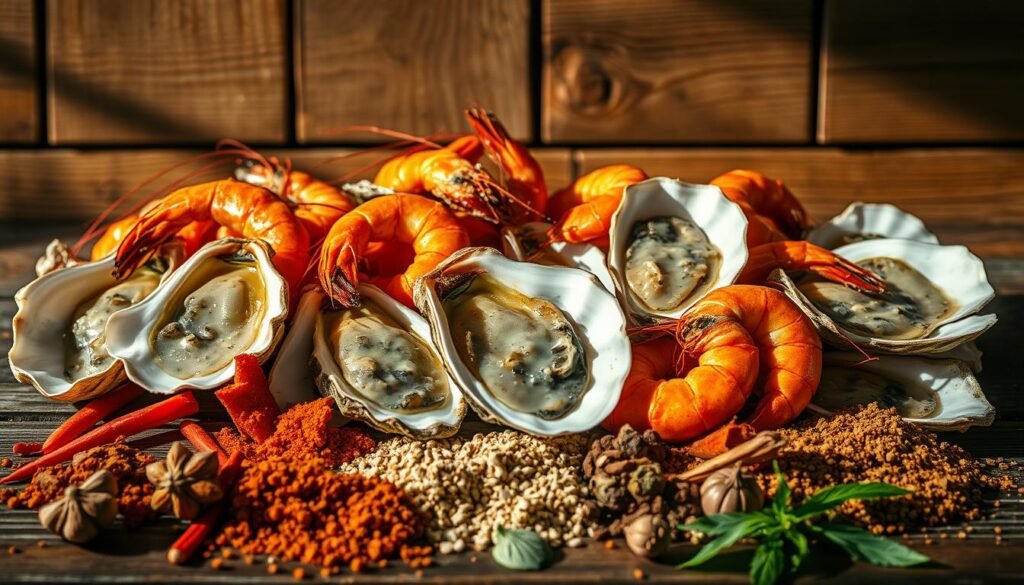
In conclusion, the iconic local ingredients in New Orleans are what make our cuisine truly special. The blend of Cajun and Creole flavors, combined with the freshness of our seafood, creates a culinary experience that is uniquely New Orleans.
Famous Restaurants Worth Visiting
When it comes to dining in New Orleans, the options are as rich and varied as the city’s history and culture. From fine dining establishments to casual eateries, the city is a culinary paradise that offers something for every palate.
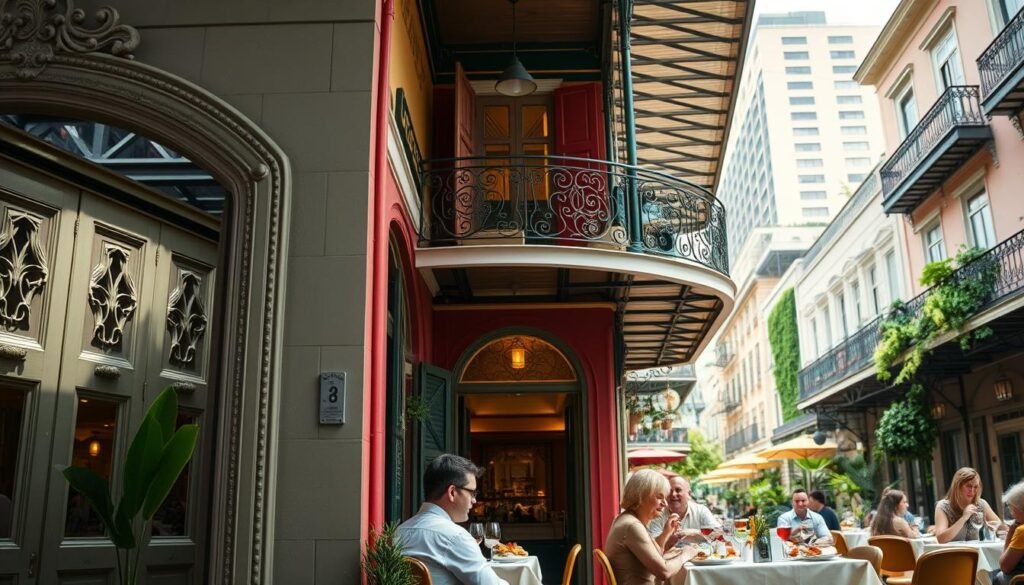
Commander’s Palace: A Culinary Landmark
Commander’s Palace is a name that resonates with foodies and locals alike. This iconic restaurant has been a benchmark for fine dining in New Orleans for decades, offering an exquisite menu that blends traditional Creole cuisine with modern twists. The service is impeccable, making it a must-visit for anyone looking to experience the best of New Orleans’ culinary scene.
The atmosphere is elegant, with a sophisticated decor that complements the refined dining experience. Whether you’re celebrating a special occasion or simply want to indulge in top-notch cuisine, Commander’s Palace is a top choice among the best restaurants in New Orleans.
Café du Monde: Beignets and Coffee
No visit to New Orleans is complete without a stop at Café du Monde. This iconic café is famous for its beignets and coffee, a simple yet irresistible combination that has been a staple of the city’s culinary landscape for generations. The moment you step into the lively atmosphere, you’re enveloped in the sweet scent of fried dough and the hum of conversation.
Sitting down at Café du Monde is an experience in itself. The café is a cultural institution, attracting visitors from all over the world who come to taste its legendary beignets. Paired with a cup of coffee, this classic New Orleans treat is a must-try when exploring the top eateries in NOLA.
Food Festivals Celebrating New Orleans Flavors
Food festivals in New Orleans are a true reflection of the city’s rich culinary heritage and cultural diversity. The city’s love affair with food is celebrated through numerous festivals that showcase its unique flavors, blending traditional Creole and Cajun cuisine with modern twists.
The culinary scene in New Orleans is vibrant, with various festivals throughout the year that attract foodies and locals alike. Two of the most notable events are the New Orleans Wine & Food Experience and the Jazz & Heritage Festival.
New Orleans Wine & Food Experience
The New Orleans Wine & Food Experience is a culinary celebration that brings together top chefs, wine experts, and food enthusiasts. This event showcases the best of New Orleans’ cuisine, with demonstrations, tastings, and dinners that highlight the city’s signature dishes.
Some of the highlights include:
- Cooking demonstrations by renowned chefs
- Wine tastings featuring local and international vintages
- Gourmet dinners at iconic venues across the city
Jazz & Heritage Festival: A Foodie’s Paradise
The Jazz & Heritage Festival is not just about the music; it’s also a foodie’s paradise. The festival features a diverse range of Creole and Cajun cuisine, from traditional gumbo and jambalaya to modern fusion dishes.
Here’s a snapshot of what you can expect at the festival:
| Food Category | Popular Dishes | Notable Vendors |
|---|---|---|
| Creole Classics | Gumbo, Jambalaya, Beignets | Cafe Maspero, Cafe Beignet |
| Modern Fusion | Crawfish Etouffee Tacos, Boudin Balls | Deanie’s, Dooky Chase’s Restaurant |
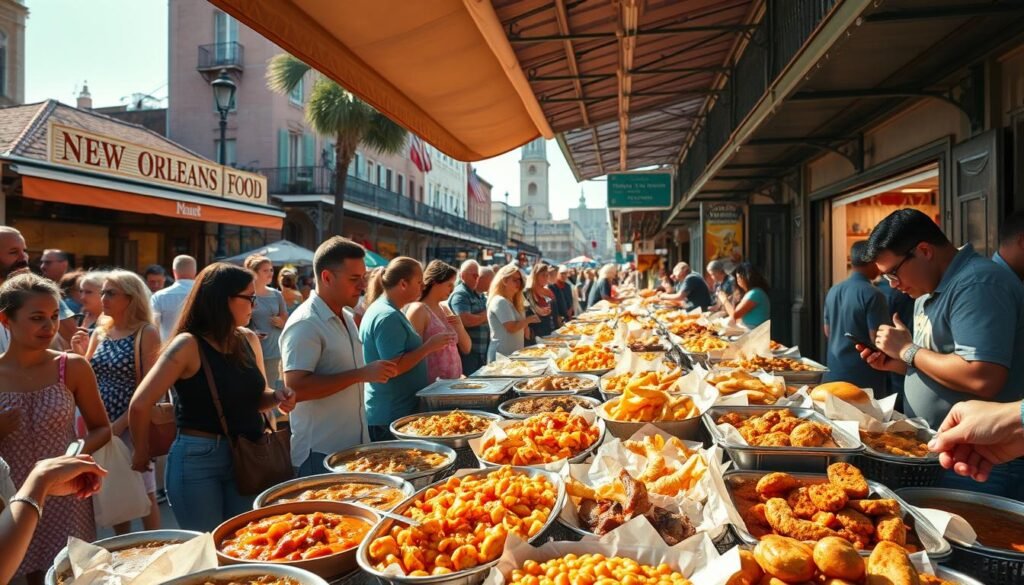
These festivals not only celebrate New Orleans’ culinary delights but also its cultural heritage, making them a must-visit for anyone looking to experience the city’s unique flavors and traditions.
Street Food and Food Trucks
From spicy po’ boys to sweet beignets, the street food in New Orleans is a foodie’s paradise. The city’s vibrant street food scene is a reflection of its rich cultural heritage, blending traditional Cajun cuisine with modern twists.
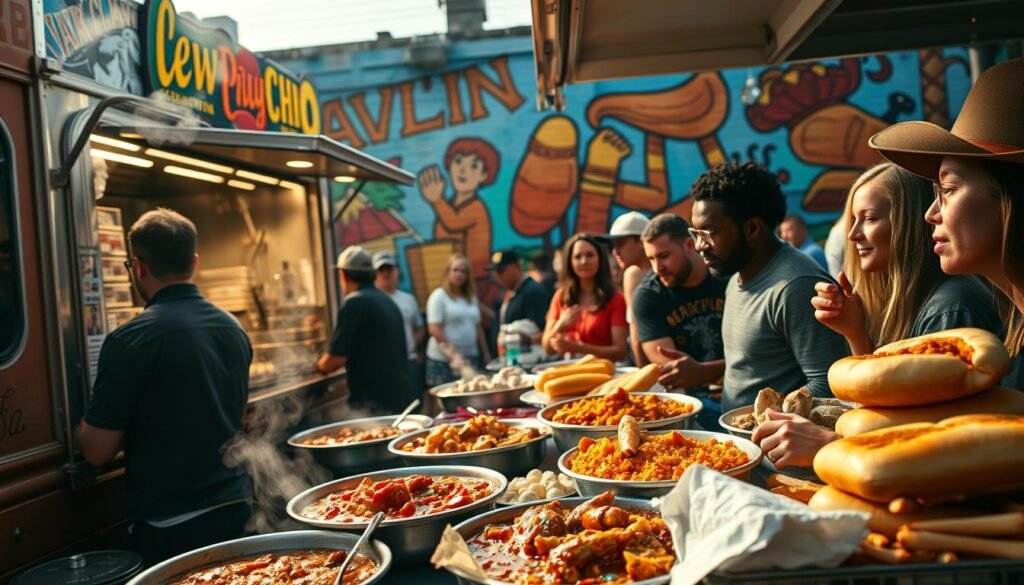
Must-Try Street Eats
When exploring the streets of New Orleans, there are several street eats you can’t miss. Po’ boys are a staple, with various fillings such as fried oysters, shrimp, or roast beef. Beignets are another must-try, covered in powdered sugar and best enjoyed with a café au lait.
- Po’ boys with fried seafood
- Beignets at Café du Monde
- Pralines, a sweet treat made from sugar, cream, and pecans
Notable Food Trucks in the City
New Orleans is also home to a variety of food trucks serving everything from Cajun favorites to international cuisine. Some notable mentions include trucks that specialize in gourmet po’ boys and others that offer creative twists on traditional dishes.
These food trucks are a great way to experience the city’s culinary diversity on the go, making them a perfect fit for the foodie favorites in the big easy crowd.
The Vibrant Bar Scene
The city’s bar scene is a reflection of New Orleans’ eclectic spirit, offering a unique blend of traditional and modern drinking experiences. As you explore the city, you’ll discover that each bar has its own story to tell, from historic haunts to modern cocktail labs.
Sipping Iconic Cocktails
New Orleans is famous for its cocktails, with the Sazerac and Hand Grenade being just two of the city’s iconic drinks. The Sazerac, often considered the official cocktail of New Orleans, is a must-try at Arnaud’s French 75 Bar or Carousel Bar & Lounge. For a taste of the Hand Grenade, head over to Pat O’Brien’s, a legendary bar known for its dueling pianos and lively atmosphere.
When sipping on these iconic cocktails, remember to pair them with the right atmosphere. For instance, the Sazerac is best enjoyed in an elegant setting, while the Hand Grenade is perfect for a more lively and energetic vibe.
Pairing Drinks with Local Dishes
Pairing your drinks with local dishes is an art form in New Orleans. For example, the spicy kick of a Pimm’s Cup complements the rich flavors of Gumbo perfectly. Similarly, a Hurricane pairs well with the spicy seafood of Blackened Redfish. Experimenting with different pairings is part of the fun, and many bars offer expert recommendations to guide you.
For a truly local experience, visit bars that are making waves nationally, and discover how they pair their signature cocktails with the city’s culinary delights.
Exploring Farmer’s Markets
From fresh produce to handmade crafts, New Orleans’ farmer’s markets are a must-visit for any food enthusiast. These markets embody the city’s culinary spirit, offering a diverse array of local flavors and artisanal goods.
Best Markets to Visit
New Orleans is home to several exceptional farmer’s markets, each with its unique charm. The Crescent City Farmers Market is a standout, featuring a wide range of local produce, from heirloom tomatoes to fresh berries. Another notable market is the French Market, which offers a mix of fresh produce, artisanal foods, and handmade crafts.
For a more local experience, the Uptown Farmers Market is a great choice, with its focus on organic and sustainable produce. These markets not only provide an opportunity to taste the best of New Orleans but also to interact with local farmers and artisans.
Local Produce and Artisanal Finds
The farmer’s markets in New Orleans are a haven for foodies. You can find an array of artisanally produced goods, including jams, honey, and baked goods. The city’s renowned Creole cuisine is well-represented, with vendors selling spices, sauces, and other specialty ingredients.
Fresh seafood is also a highlight, with many markets featuring locally caught fish and shellfish. Whether you’re looking to cook a meal or simply want to sample the local flavors, New Orleans’ farmer’s markets are an ideal destination.
By visiting these markets, you’re not only experiencing the best of New Orleans’ culinary delights but also supporting local farmers and artisans. So, take a stroll through the markets, and indulge in the city’s rich gastronomic culture.
New Orleans Cuisine at Home
Bringing the flavors of New Orleans into your home kitchen is easier than you think, thanks to a wealth of cookbooks and recipes inspired by the city’s rich culinary heritage. Whether you’re a seasoned chef or a culinary newcomer, the world of Cajun and Creole cuisine is full of exciting possibilities.
Cookbooks for the Modern Chef
For those looking to dive into the world of New Orleans cooking, having the right cookbooks can make all the difference. Here are some essential cookbooks for home chefs:
- The New Orleans Cookbook by Rilda C. Hylton – A comprehensive guide to traditional New Orleans recipes.
- Cajun and Creole Cookery by C.J. Prudhomme – Offers a deep dive into the spices and techniques that define Cajun and Creole cuisine.
- New Orleans Kitchen by Karen Warner – Explores the contemporary side of New Orleans cuisine while maintaining its traditional roots.
Popular Recipes to Try
Some dishes are quintessentially New Orleans, and trying them at home is a great way to experience the city’s cuisine. Here are a few popular recipes to get you started:
- Gumbo – A hearty soup that combines ingredients like okra, rice, and a variety of meats and seafood.
- Jambalaya – A one-pot dish that mixes sausage, chicken, and rice, showcasing the bold flavors of New Orleans.
- Beignets – These sweet fried dough pastries are a classic New Orleans treat, perfect for breakfast or dessert.
These recipes, along with the cookbooks mentioned, will give you a solid foundation in New Orleans cuisine and help you bring a taste of the Big Easy into your home.
Impact of Culture and Heritage on Food
In New Orleans, the flavors on your plate are a direct result of the city’s diverse cultural influences. The city’s cuisine is a testament to its history as a melting pot of cultures, with African, European, and indigenous American influences shaping its culinary identity.
The significance of culture and heritage in New Orleans cuisine cannot be overstated. It’s a city where traditional dishes are not just meals, but a way to connect with the past and celebrate the present. As we explore the impact of culture and heritage on food, we’ll delve into how traditions are celebrated through cooking and the role of festivals in showcasing the city’s culinary delights.
Celebrating Traditions Through Cooking
Cooking in New Orleans is often a family affair, with recipes passed down through generations. Traditional dishes like gumbo, jambalaya, and beignets are more than just food; they’re a connection to the city’s history and cultural heritage.
- Gumbo: A hearty stew that reflects the city’s African, French, and Native American influences.
- Jambalaya: A one-pot dish that combines sausage, rice, and a variety of meats and seafood, showcasing the city’s cultural diversity.
- Beignets: These sweet fried dough pastries are a classic New Orleans treat, covered in powdered sugar and enjoyed with café au lait.
As doyenne of Creole cuisine, Leah Chase once said, “Food is the way we communicate with our families and friends, and it’s a way we show our love.” This quote encapsulates the spirit of cooking in New Orleans, where food is a universal language that brings people together.
Festivals and Their Culinary Significance
New Orleans is renowned for its vibrant festival scene, with many events celebrating the city’s culinary heritage. The New Orleans Wine & Food Experience and the Jazz & Heritage Festival are just two examples of how the city comes together to celebrate its food culture.
During these festivals, the city’s culinary delights take center stage, with local chefs, restaurants, and food vendors showcasing their talents. It’s a time when the city’s diverse culinary influences come together, creating a truly unique gastronomic experience.
Key festivals include:
- New Orleans Wine & Food Experience: A celebration of the city’s culinary scene, featuring wine tastings, cooking demonstrations, and more.
- Jazz & Heritage Festival: A showcase of the city’s music, culture, and cuisine, with a focus on local and regional specialties.
These festivals not only highlight the city’s culinary achievements but also serve as a reminder of the importance of preserving cultural heritage through food. As we continue to explore the culinary delights of New Orleans, it’s clear that the city’s culture and heritage are inextricably linked to its cuisine.
Food Tours: A Taste of the City
Exploring New Orleans through its food tours is a culinary adventure like no other. Whether you’re a food enthusiast or just looking to experience the city’s renowned dining scene, there’s a tour out there for you. A New Orleans dining experience is not just about the food; it’s about immersing yourself in the city’s rich history and culture.
Guided Tours to Savor
For those who prefer a guided experience, New Orleans offers some of the best food tours in the country. Companies like New Orleans Food Tours and Crescent City Food Tours offer insider access to top eateries in NOLA, from iconic restaurants to hidden gems. These tours provide a taste of the city’s diverse culinary landscape, showcasing everything from beignets to gumbo.
Planning Your Own Culinary Journey
If you prefer to venture out on your own, consider creating a self-guided tour. Start by mapping out some of the city’s must-visit spots, like Café du Monde for beignets or Commander’s Palace for a taste of haute Creole cuisine. Don’t be afraid to wander the streets of the French Quarter and explore its many culinary delights. With a little planning, you can curate your own New Orleans dining experience that’s tailored to your tastes.
FAQ
What’s the best way to experience the New Orleans food scene?
To truly experience the New Orleans food scene, take a culinary tour, visit iconic restaurants like Commander’s Palace, and explore the city’s vibrant street food and food trucks. Be sure to try some of the city’s signature dishes like gumbo, jambalaya, and beignets.
What are some must-try dishes in New Orleans?
Some must-try dishes in New Orleans include gumbo, jambalaya, beignets, po’ boys, and pralines. Be sure to also try some of the city’s fresh seafood, like oysters and shrimp, and some of the local specialties like andouille sausage and crawfish.
What’s the difference between Cajun and Creole cuisine?
Cajun cuisine originated from the Acadian people who settled in rural Louisiana, and is characterized by its use of local ingredients like crawfish, andouille sausage, and spices. Creole cuisine, on the other hand, is a blend of French, Spanish, African, and Caribbean flavors, and is often associated with the city’s sophisticated culinary scene.
What are some of the best food festivals in New Orleans?
Some of the best food festivals in New Orleans include the New Orleans Wine & Food Experience, the Jazz & Heritage Festival, and the French Quarter Festival. These events showcase the city’s culinary delights, with top chefs, wine experts, and local food vendors coming together to celebrate the city’s rich culinary heritage.
Can I bring New Orleans cuisine home to cook?
Yes, you can bring New Orleans cuisine home to cook! Try using some of the city’s iconic ingredients like andouille sausage, crawfish, and spices to make classic Creole dishes like gumbo and jambalaya. You can also find a range of cookbooks and recipes online to help you get started.
What’s the best way to pair drinks with New Orleans cuisine?
New Orleans is famous for its cocktails, and pairing drinks with the city’s cuisine is a must. Try pairing a Sazerac with some of the city’s rich Creole dishes, or a Hand Grenade with some of the city’s spicy Cajun cuisine. You can also pair some of the city’s fresh seafood with a crisp glass of white wine.
Are there any good farmer’s markets in New Orleans?
Yes, there are several great farmer’s markets in New Orleans, including the Crescent City Farmers Market and the French Market. These markets offer a range of local produce, artisanal goods, and prepared foods, and are a great way to experience the city’s culinary delights.
Can I take a self-guided food tour in New Orleans?
Yes, you can take a self-guided food tour in New Orleans! The city is relatively walkable, and many of the city’s iconic restaurants and food vendors are located in the French Quarter and other central neighborhoods. You can also use online resources and guidebooks to plan your own culinary adventure.
